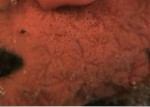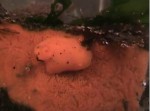The red sponge, Ophlitaspongia pennata and the nudibranch Rostanga sp. were found at a low tide in the late evening in November near the end of the docks, just beside the slipway at Race Rocks. These images are from the video below.
- Note grooves in the surface of the sponge which are grazing paths.
- The nudibranch Rostanga grazing on the red sponge.
There are likely to be several types of encrusting red sponges growing in narrow crevices and on the undersides of overhanging ledges. Indeed, there are about ten intertidal species of red to orange encrusting sponges along the Pacific coast. Ophlitaspongia pennata is a beautifully coral-red form characterized, especially after drying, by starry oscula; its surface is velvety. De Laubenfels (1932) remarked that it occurs clear up to the half-tide mark (higher up than any other sponge), especially on vertical rocks under pendant seaweed, hence shaded from direct sunlight. Ophlitaspongia pennata is recorded from (Vancouver Island), British Columbia, to near Puertocitos, Baja California.
| Domain | Eukarya |
| Kingdom | Animalia |
| Phylum | Porifera |
| Class | Demospongiae |
| Order | Poecilosclerida |
| Family | Clathriidae |
| Subclass | Ceractinomorpha |
| Genus | Ophlitaspongia |
| Species | pennata |
| Common Name | Velvety Red Sponge/ Red Midtide Sponge |
This type of Red Sponge can be colored bright red to almost a dull orange-red. It has a smooth and tough surface. It has holes scattered around on it: the holes are about 2 millimeters wide. Its predators are nudibranchs, snails and seastars. They feed on shrimp, crabs and many other organisms.These tiny flat red to orange colored sponges encrust vertically on rocks shaded from sunlight.Biotic Associations: Often found with a predator, Rostanga pulchra
| This file is provided as part of a collaborative effort by the students, faculty, staff and volunteers of Lester B. Pearson College | February 2002 | Sarah MonsalveR. Colombia PC Yr 28 |


